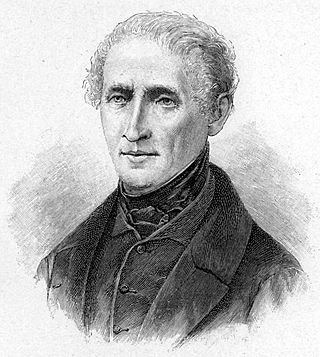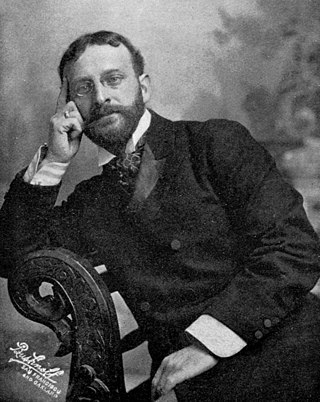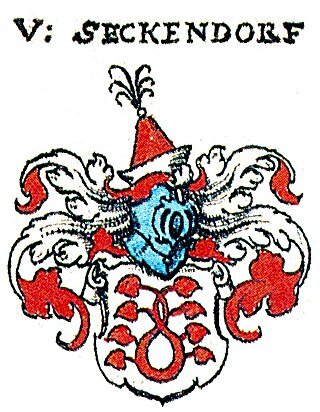
Heinrich Rudolf Hertz was a German physicist who first conclusively proved the existence of the electromagnetic waves predicted by James Clerk Maxwell's equations of electromagnetism. The unit of frequency, cycle per second, was named the "hertz" in his honor.

In physics, radiation is the emission or transmission of energy in the form of waves or particles through space or through a material medium. This includes:

Spectroscopy is the field of study that measures and interprets the electromagnetic spectra that result from the interaction between electromagnetic radiation and matter as a function of the wavelength or frequency of the radiation. Matter waves and acoustic waves can also be considered forms of radiative energy, and recently gravitational waves have been associated with a spectral signature in the context of the Laser Interferometer Gravitational-Wave Observatory (LIGO).

Joseph Freiherr von Eichendorff was a German poet, novelist, playwright, literary critic, translator, and anthologist. Eichendorff was one of the major writers and critics of Romanticism. Ever since their publication and up to the present day, some of his works have been very popular in Germany.

Hormesis is a characteristic of many biological processes, namely a biphasic or triphasic response to exposure to increasing amounts of a substance or condition. Within the hormetic zone, the biological response to low exposures to toxins and other stressors is generally favorable. The term "hormesis" comes from Greek hórmēsis "rapid motion, eagerness", itself from ancient Greek hormáein "to set in motion, impel, urge on", the same Greek root as the word hormone. The term 'hormetics' has been proposed for the study and science of hormesis.

Otmar Freiherr von Verschuer was a German-Dutch human biologist and geneticist, who was the Professor of Human Genetics at the University of Münster until he retired in 1965. A member of the Dutch noble Verschuer family, his title Freiherr is often translated as baron.
Torsional vibration is the angular vibration of an object - commonly a shaft - along its axis of rotation. Torsional vibration is often a concern in power transmission systems using rotating shafts or couplings, where it can cause failures if not controlled. A second effect of torsional vibrations applies to passenger cars. Torsional vibrations can lead to seat vibrations or noise at certain speeds. Both reduce the comfort.

Carl Gustav Carus was a German physiologist and painter, born in Leipzig, who played various roles during the Romantic era. A friend of the writer Johann Wolfgang von Goethe, he was a many-sided man: a doctor, a naturalist, a scientist, a psychologist, and a landscape painter who studied under Caspar David Friedrich.
High-energy X-rays or HEX-rays are very hard X-rays, with typical energies of 80–1000 keV (1 MeV), about one order of magnitude higher than conventional X-rays used for X-ray crystallography. They are produced at modern synchrotron radiation sources such as the beamlines ID15 and BM18 at the European Synchrotron Radiation Facility (ESRF). The main benefit is the deep penetration into matter which makes them a probe for thick samples in physics and materials science and permits an in-air sample environment and operation. Scattering angles are small and diffraction directed forward allows for simple detector setups.
Energy medicine is a branch of alternative medicine based on a pseudo-scientific belief that healers can channel "healing energy" into a patient and effect positive results. The field is defined by shared beliefs and practices relating to mysticism and esotericism in the wider alternative medicine sphere rather than any sort of unified terminology, leading to terms such as energy healing or vibrational medicine being used as synonymous or alternative names. In most cases there is no empirically measurable energy involved: the term refers instead to so-called subtle energy. Practitioners may classify the practice as hands-on, hands-off, and distant where the patient and healer are in different locations. Many schools of energy healing exist using many names: for example, biofield energy healing, spiritual healing, contact healing, distant healing, therapeutic touch, Reiki or Qigong.

Günther Freiherr von Maltzahn was a German military aviator and wing commander in the Luftwaffe during World War II. As a fighter ace, he was credited with 68 enemy aircraft shot down in 497 combat missions. He claimed 34 aerial victories over the Eastern Front and 34 aerial victories over the Western Front, including one four-engine bomber. He was awarded the Knight's Cross of the Iron Cross with Oak Leaves, which was Germany's highest military decoration at the time of its presentation to Maltzahn.

Radionics—also called electromagnetic therapy (EMT) and the Abrams Method—is a form of alternative medicine that claims that disease can be diagnosed and treated by applying electromagnetic radiation (EMR), such as radio waves, to the body from an electrically powered device. It is similar to magnet therapy, which also applies EMR to the body but uses a magnet that generates a static electromagnetic field.

Carl Ludwig Schleich was a German surgeon and writer. He is best known for his contribution to clinical anesthesia. In addition, he was also a philosopher, poet and painter.
Ernst Hartmann in Germany was a German medical doctor, author and publicist.
The Haitinger Prize of the Austrian Academy of Sciences was founded in 1904 by the chemist and factory director, Ludwig Camillo Haitinger (1860–1945), who created the award in honor of his father, Karl Ludwig Haitinger. From 1905 to 1943 it was awarded every year, for "studies in chemistry and physics that proved to be of great practical use for industrial applications". The prize was awarded for the last time in the year 1954.

The House of Seckendorff is the name of an old and prolific Franconian noble family. According to historian Werner Wagenhöfer, the Seckendorff family is the most researched family of the low nobility in Franconia along with the Guttenberg and Bibra families.

Kapitaï and Koba were two areas on the coast of West Africa which were the object of German colonial initiatives in 1884 and 1885. They lay between the Pongo and Dubréka rivers, south of Senegal and Gambia in modern Guinea; in the terms commonly used in the 19th century they were considered part of Senegambia. The short-lived German colony there was known as the Dembiah colony or Colinsland.

Ronald Grossarth-Maticek is a German sociologist specializing in the field of medical sociology, working in the fields of psychosomatics, psycho-oncology and health promotion. He is the director of the Institute for Preventive Medicine and professor for postgraduate studies (ECPD). In 2019, some of the works of Maticek and his co-author, psychologist Hans Eysenck, were reviewed by King's College London and 26 were declared "unsafe".
Geobiology is a field which studies the effects of the Earth's radiation, such as telluric currents and other electromagnetic fields, on biological life. The term is derived from Ancient Greek gē (ge) meaning ‘earth’ and βίος; (bios) meaning ‘life’. Its findings have not been scientifically proven; thus, it is considered a subsection of pseudoscience.
Ruediger Dahlke is best known for the many books and articles on health issues, translated into more than 20 languages. His work centers on psychosomatics, spiritual philosophy, nutrition and esoteric.













